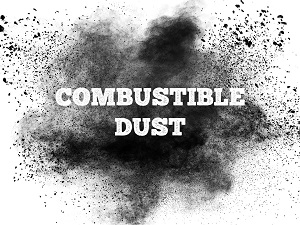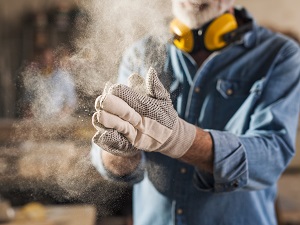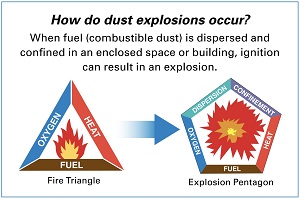It’s extremely important for employers and workers to understand if the facility they are working in is creating, or capable of creating, combustible dust.

Almost any solid material that burns can be combustible when finely divided into a dust. A piece of wood becomes combustible dust when reduced to sawdust and even materials that do not burn in larger pieces, like aluminum or iron, can be combustible in dust form.
Certain materials in their pure chemical state will not form combustible dust, including cement, sand, gypsum, limestone, and salt.
Combustible dust hazard assessments, dust and ignition control measures, emergency action plans, and overall worker safety are the responsibility of management, but workers must be trained to recognize and prevent hazards associated with combustible dust. Workers in the facility can be instrumental in recognizing unsafe conditions, taking preventative action, and alerting management.

The potential for a dust explosion depends on many factors, including the dust particle’s size, shape, and moisture content, the method of dispersion, ventilation systems, air currents, physical barriers, and the volume of the area in which the dust cloud exists.
When combustible dust in the proper concentration is dispersed (spread out) in a cloud, and then ignited, a flash fire occurs.
When a flash fire is confined, in a space that is contained, the pressure that develops can cause an explosion. The confinement could be a room, processing equipment, a dust collector, a conveyor, or an entire building.
The flying shrapnel, blast wave, and building collapse caused by the explosion can cause severe injuries, fatalities, and property damage.
A fire require oxygen, heat, and fuel. An explosion requires oxygen, heat, fuel (dust), dispersion, and confinement.

If there is an explosion caused by combustible dust, there is a danger of even more explosions that can happen soon after.
Primary Explosion refers to the first combustible dust explosion.
Secondary Explosion refers to additional explosions that happen as the heat from the initial blast reaches more accumulated dust in other areas of the facility.
Combustible dust can accumulate on any upward facing surface and fine dust can even cling to vertical surfaces, like walls. The build-up of even a small amount of dust on surfaces like rafters, roofs, suspended ceilings, ducts, and windowsills can cause serious damage if an explosion occurs.
Secondary explosions can continue to ignite in sequence, cascading throughout a facility, and can often be far more destructive than the primary explosion.

Preventing catastrophic dust explosions starts with a thorough hazard assessment. Any activity that creates dust should be investigated to determine if there is a risk that the dust is combustible.
To identify factors that may contribute to an explosion, facilities should carefully review these areas and situations to assess the potential for dust explosions:
- Materials that can be combustible when finely divided
- Processes which use, consume, or produce combustible dusts
- Hidden areas where combustible dusts may accumulate and settle
- Open areas where combustible dusts may build up
- Means by which dust may be dispersed in the air
- Potential ignition sources
During the assessment, consider all ignition sources including hot work, hot surfaces, static electricity, incandescent material, heat caused by friction, self-heating (spontaneous combustion), and sparks caused by impacts, friction, or electrical components.
OSHA Standard 1910.307(c) Electrical equipment, wiring methods, and installations of equipment in hazardous locations shall be intrinsically safe, approved for the hazardous location, or safe for the hazardous location.
After hazards have been identified, one or more prevention, protection and/or mitigation methods may be implemented for dust control, ignition control, and protection measures.

While dust control measures will vary for each facility, the general approach focuses on the three Cs—capture, contain, and clean.
Capture dust before it escapes into a work area by using properly designed, installed, approved, and maintained dust collection systems.
Contain dust within equipment, systems, or rooms that are built and operated to safely handle combustible dust.
Clean work areas, overhead surfaces and concealed spaces frequently and thoroughly using safe housekeeping methods to remove combustible dusts not captured or contained.
OSHA Standard 1910.22(a)(1) All places of employment, passageways, storerooms, service rooms, and walking-working surfaces are kept in a clean, orderly, and sanitary condition.
Ignition control is an important component of preventing combustible dust explosions. General ignition control recommendations include:
- Use appropriate electrical equipment and wiring methods.
- Heating systems should be in areas where dust does not build up.
- Open flames, hot work, sparks, and smoking should be regulated, and monitored if necessary.
- Use forklifts, equipment, and tools properly.
- Control static electricity, including bonding of equipment to ground.

.jpg)

